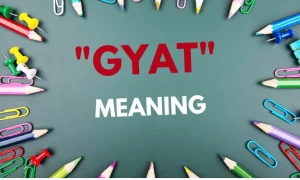What Does ‘GYAT’ Mean? Understanding the Kids’ Latest Phrase
The latest internet slang that has caught the fancy of kids these days is ‘GYAT’. An acronym, ‘GYAT’ stands for ‘Get You A Thot’, a phrase quite popular in internet culture and primarily used within online gaming communities. Essentially, it is a form of colloquial advice suggesting that one should seek out a partner who is considered attractive or desirable, often with a specific connotation of promiscuity. The term ‘Thot’ itself is an acronym, standing for ‘That Hoe Over There’, and has seen widespread use on social media platforms such as Twitter and Instagram. However, it’s important to note that the term is quite controversial due to its derogatory nature and is often considered disrespectful and offensive.
As the internet continues to evolve, the language used by its users, especially young people, is also changing rapidly, incorporating acronyms and abbreviations as a part of their daily communication. The use of ‘GYAT’ is merely one example of this cultural shift. While it can be challenging for parents and educators to keep up with these ever-evolving phrases, understanding them is crucial to effectively communicate and engage with the younger generation. However, it’s also important to teach them about the potential implications and repercussions of using such terms, ensuring they maintain respect and consideration for others in their online interactions.

The Origin of ‘GYAT’
The term ‘GYAT’ is an acronym that traces its roots back to social media, specifically Twitter. It stands for ‘Get Yourself A Treat,’ and it first gained traction around 2019. The acronym initially began as a hashtag used by self-care enthusiasts or those advocating for mental health awareness. The phrase encourages individuals to indulge in activities or items that bring them joy or assist in their personal growth. It signifies the philosophy of rewarding oneself, no matter how small or big the achievement may be.
The term ‘treat’ is subjective and can vary from person to person. For some, it could be buying a new book, enjoying a favorite dessert, or spending time on a loved hobby. For others, it could mean taking a day off from work or school, going for a spa day, or enjoying an outdoor activity. Part of the charm of ‘GYAT’ lies in its flexibility and adaptability to individual needs. This term has since grown popular and is now commonly used on various social media platforms like Instagram, Facebook, and Snapchat. ‘GYAT’ has evolved into a universal symbol of self-love and care, promoting the idea that everyone deserves a treat for their efforts and achievements. Its popularity testifies to the growing global trend of prioritizing mental health and overall well-being.
How Kids Are Using ‘GYAT’ Today
‘GYAT’, an abbreviation for ‘Get Yourself a Tutor’, is a contemporary term gaining popularity among the younger generation today. This phrase has surfaced from the recognition of the importance of extra academic assistance outside traditional classrooms. Children are using ‘GYAT’ as a casual call to action amidst their peers, encouraging them to seek additional help to bolster their understanding of complex subjects. The phrase is often used in online communities, social media platforms, and educational forums, where peers motivate each other to pursue academic excellence.
The rise of ‘GYAT’ also reflects the growing acceptance and normalization of seeking help in education. Today’s youth are more prone to recognizing gaps in their knowledge and are willing to take steps to address them. This trend is facilitated by the internet, which provides a plethora of platforms offering tutoring services across various subjects. Children now have easy access to skilled tutors online from around the world, making education more versatile and personalized.
Moreover, the phrase ‘GYAT’ embodies an attitude of self-improvement and personal responsibility. It suggests that children now understand the importance of taking charge of their own education and success. They see tutoring not as a sign of weakness or failure, but as a tool for enhancement and a means to gain an edge in an increasingly competitive academic landscape.
In conclusion, the usage of ‘GYAT’ by kids today indicates a cultural shift in attitudes towards education and learning. It represents a proactive approach, where getting a tutor is seen as a positive step towards self-improvement and academic advancement. By adopting the ‘GYAT’ mantra, children are not only enriching their knowledge but also fostering a culture of continuous learning and growth.

Is It Okay for Parents to Use ‘GYAT’?
Discussing whether or not it is acceptable for parents to use the acronym ‘GYAT’ (Get Your Act Together) when dealing with their children brings up a myriad of perspectives. Central to this debate is the question of appropriateness and the impact on the child’s mental and emotional wellbeing. On one hand, some parents and child psychologists argue that using terms like ‘GYAT’ can be seen as a motivational tool to inspire their children to improve their behavior or performance in various life areas such as academics or sports. They believe it could serve as a wake-up call to make them realize the importance of responsibility and accountability.
On the other hand, critics of this approach argue that it may lead to unnecessary pressure and stress on the child, possibly resulting in feelings of inadequacy or low self-esteem. This group believes that continuous use of ‘GYAT’ can potentially become a form of verbal abuse if not used thoughtfully and sparingly. It may create a hostile environment where the child feels constantly criticized and never good enough. Instead, they suggest a more gentle and supportive approach, where parents express their concerns and expectations in a more empathetic and constructive manner.
The acceptability of using ‘GYAT’ also depends on the context and the relationship between the parent and child. In a household where open communication and mutual respect are the norms, a parent saying ‘GYAT’ might be seen as a simple, straightforward reminder. However, in a more sensitive situation, it could be taken negatively. Therefore, while some might see it as a necessary phrase to push their children towards betterment, others might view it as a harsh and potentially damaging method. It’s essential for parents to consider their child’s individual personality and emotional capacity before using such terms.
How ‘GYAT’ Is Used in Popular Culture
‘GYAT,’ an acronym standing for ‘Get Yourself A Therapist,’ is a phrase that has seen extensive use in popular culture, particularly on social platforms. It has become a trending phrase on the internet and social media platforms such as Twitter, Instagram, and Reddit, often used in response to individuals sharing personal struggles or challenges they may be dealing with. The phrase has been commonly utilized by younger generations, who are typically more open about mental health issues, and is seen as a way to encourage people to seek professional help. However, the usage of ‘GYAT’ in popular culture has sparked debates about its appropriateness and impact on mental health discourse.
Some believe it trivializes serious mental health issues and discourages open discussions about personal struggles. Others argue it’s a humorous and light-hearted approach to break the stigma surrounding therapy and mental health treatment. The usage of ‘GYAT’ reflects a broader trend in popular culture where mental health is becoming a mainstream topic of conversation, with celebrities and influencers frequently advocating for mental health awareness and the importance of professional help. As the discourse around mental health evolves, the usage and interpretation of ‘GYAT’ in popular culture will continue to change and adapt. Ultimately, the phrase symbolizes a cultural shift towards acknowledging and addressing mental health issues.

The Evolution of ‘GYAT’ and Its Impact on Trends
The concept of ‘Give Yourself A Try’ or ‘GYAT’ emerged as a prominent cultural phenomenon in recent years, largely influenced by the millennial and Gen Z generations’ push for personal development and self-realization. Originally popularized by the British band, The 1975, in their hit song of the same name, ‘GYAT’ quickly became a rallying cry for individuals to step out of their comfort zones and experiment with new experiences, ideas, and perspectives. As such, it has had a profound impact on various trends, particularly in the realms of fashion, lifestyle, and digital media.
For instance, in fashion, ‘GYAT’ has fueled the rise of unconventional styles and the blurring of gender norms, with individuals encouraged to experiment with different looks and aesthetics. In the lifestyle sector, ‘GYAT’ has manifested in the form of wellness and self-care trends, with more and more people prioritizing activities that promote mental and physical well-being. In the digital world, ‘GYAT’ has empowered users to express themselves authentically and fearlessly, leading to more diverse and inclusive content. Moreover, ‘GYAT’ has sparked a shift in consumer behavior, with individuals increasingly valuing experiences over material possessions. Marketers and businesses have had to adapt to this new mindset, creating products and services that cater to this desire for personal growth and self-discovery. In essence, the evolution of ‘GYAT’ has not only transformed societal norms and values but also redefined the parameters of trendsetting. It serves as a testament to the power of cultural movements in shaping societal trends and influencing individual behavior.
